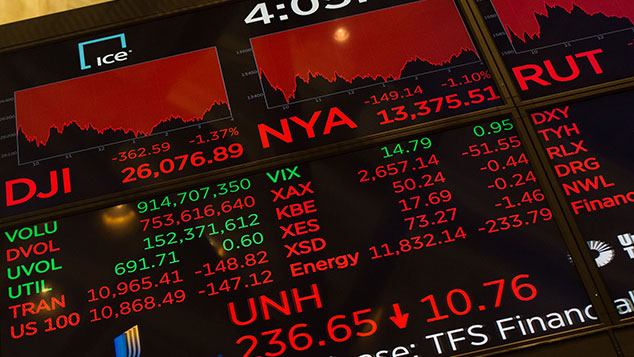
So that’s it. Show’s over, folks.
The Dow Jones has recovered from Monday’s rout. It’s not back to an all-time high yet, but it’s chugging its way up there.
So has “buy the dip” triumphed yet again?
Maybe.
But you know what else has clawed its way back to where it was at the tail-end of last week?
The very thing that many people assume triggered this panic in the first place – bond yields.
Don’t panic – but don’t just shrug this off either
The US ten-year government bond is now yielding above 2.8% again. That’s where it was when everyone started getting really panicky on Friday.
Does that mean none of this had anything to do with rising bond yields, or fears of rising interest rates?
No, it just means that things take time to sink in.
There were lots of reasons for the crash at the start of the week. There are many soothing voices on the internet right now. Most of them are money managers, who depend on their clients not panicking.
Their advice may be self-interested (no one wants to lose clients). But it’s also reasonable. Panicking is counter-productive. Anyone who sold at the bottom of the 1,000-plus point crash in the Dow is now in a far worse psychological state than they were before.
Many will have bought back in higher up and cost themselves a load of money in fees and crystallised losses on the round trip. And come the next crash, they’ll be even more inclined to panic. (This is one area where a good financial advisor or wealth manager can really prove their worth, by the way – by operating as a behavioural check on your own instinctive self-destructive tendencies.)
However, I don’t think it’s a good idea to just wave your hand and say: “Why does the market crash? Ah, more sellers than buyers.”
The market had gone up too far, too fast, it’s true. The crash was at least partly the result of that. And you can always point to 1987 as being a good example of a time when you really should have just bought and held all the way through.
But it’s also clear that on this occasion that something significant has changed. And without getting all melodramatic about it, it’s worth you being aware of that and taking precautions accordingly.
Bull markets don’t collapse overnight
Bull markets take a while to crumble. The big change in 2006 was that US house prices started to fall. It didn’t take long for the trouble to start showing in the more vulnerable areas of the market.
Housebuilders’ stocks began to fall in 2006. In the first half of 2007, mortgage brokers began to shut down in droves (and HSBC issued an early profit warning driven by the same issue). In summer 2007, the trouble in the mortgage-backed securities market showed up as various minor hedge funds blew up. And in September, Northern Rock went bust.
Yet, believe it or not, the FTSE 100 hit a fresh peak a month after Northern Rock had collapsed. You’d have thought that the first genuine, queueing-out-the-door bank run in British history since forever would have been enough to make people wake up to the idea that there was a bigger problem out there. But no – reassuring noises by central banks managed to keep the party going right up until then.
My point is that it takes time for the market to react to change. It’s hard to shrug off a cosy narrative that everyone was enjoying, and then take on the onerous task of rethinking it. Thinking is hard work. We’ll do just about anything to avoid it (that’s Facebook’s entire business model in a nutshell).
So we can see various things changing around us. But we bat them aside and put off thinking about them until tomorrow. As long as the market’s going up, it’s OK.
So the cracks in the ice of the narrative keep appearing. Wages are going up around the world (which is, I reiterate, a good thing). Commodity prices have (until this week) perked up. Bond yields are getting to levels where they are undeniably “breaking out”. Central banks are moving towards tightening, not loosening.
And the areas that are most vulnerable are starting to pop. Who was at the sharpest end of the subprime crisis? The hedge funds who owned the CDOs. Who was at the sharp end of the global epic bet on complacency? The products that were designed to short the Vix.
Yet everyone carries on skating along blithely, until there are too many cracks to ignore.
Just to be clear, I’m not saying that the next crisis will be a repeat of 2008 – indeed I think it’ll be pretty much the diametric opposite, in that it’ll be an inflationary crisis rather than a deflationary one.
But I do reckon that at some point we’ll look back at the short-volatility products blowing up and say: “Ah. That was an early warning sign.”